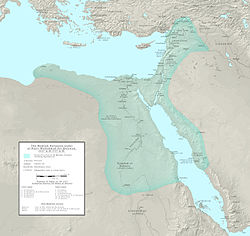
Back المماليك البحرية Arabic المماليك البحريه ARZ Dinastía bahrí AST Bəhrilər Azerbaijani বাহরি রাজবংশ Bengali/Bangla Dinastija Bahri BS Dinastia bahrita Catalan مەمالیکی بەحری CKB Bahri-Dynastie German Dinastía bahrí Spanish
State of the Turks دولة الأتراك (Arabic) | |||||||||
|---|---|---|---|---|---|---|---|---|---|
| 1250–1382 | |||||||||
|
Flags according to the Catalan Atlas of c. 1375 | |||||||||
| Personal insignia of Baybars from 1260 | |||||||||
 The Mamluk Sultanate circa 1317 AD | |||||||||
| Status | Sultanate under the Abbasid Caliphate | ||||||||
| Capital | Cairo | ||||||||
| Religion | Sunni Islam | ||||||||
| History | |||||||||
• Established | 1250 | ||||||||
• Disestablished | 1382 | ||||||||
| |||||||||
The Bahri Mamluks (Arabic: المماليك البحرية, romanized: al-Mamalik al-Baḥariyya), sometimes referred to as the Bahri dynasty,[1][2] were the rulers of the Mamluk Sultanate of Egypt from 1250 to 1382, following the Ayyubid dynasty. The members of the Mamluk ruling class were purchased as slaves (mamluks) and manumitted, with the most powerful among them taking the role of sultan in Cairo.[3] While several Bahri Mamluk sultans tried to establish hereditary dynasties through their sons, these attempts were ultimately unsuccessful, with the role of sultan often passing on to another powerful Mamluk.[3]
The Bahri Mamluks were of mostly Kipchak Turkic origin.[3][4] Fourteen of eighteen sultans between 1279 and 1390 belonged to the Qalawunid lineage.[5] After 1382/1390, they were succeeded by a second Mamluk regime, the Burji Mamluks, who were largely of Circassian origin.[6] The name Bahri or Bahriyya means 'of the river', referring to the location of their original barracks on Roda Island in the Nile (Nahr al-Nil) in Cairo,[a] at the citadel of Al-Rodah which was built by the Ayyubid sultan as-Salih Ayyub.[8][b]
- ^ Shoup, John A. (2017). The Nile: An Encyclopedia of Geography, History, and Culture. ABC-CLIO. p. 170. ISBN 978-1-4408-4041-8.
- ^ Flood, Finbarr Barry; Necipoğlu, Gülru (2017). A Companion to Islamic Art and Architecture. Wiley Blackwell. p. 579. ISBN 978-1-119-06857-0.
- ^ a b c Bosworth, C. E. (1996). "The Mamluks". New Islamic Dynasties: A Chronological and Genealogical Manual. Edinburgh University Press. pp. 76–80. ISBN 978-1-4744-6462-8.
- ^ Naylor, Phillip C. (2015). North Africa, Revised Edition: A History from Antiquity to the Present. University of Texas Press. p. 111. ISBN 978-0-292-76190-2.
- ^ Jo Van Steenbergen, "The Mamluk Sultanate as a military patronage state: Household politics and the case of the Qalāwūnid Bayt (1279-1382)." Journal of the Economic and Social History of the Orient 56.2 (2013): 189–217.
- ^ Bosworth, C. E. (1996). "The Mamluks". New Islamic Dynasties: A Chronological and Genealogical Manual. Edinburgh University Press. pp. 76–80. ISBN 978-1-4744-6462-8.
- ^ Shayyal, 110/vol.2
- ^
- Al-Maqrizi, p. 441/vol.1
- Abu Al-Fida, pp.66-87/ Year 647H - Death of as-Sailih Ayyub
- Ibn Taghri/vol.6 - Year 639H
- ^ Al-Maqrizi, p.405/vol. 1
- ^ Al-Maqrizi, al-Mawaiz, p. 327/vol.3
Cite error: There are <ref group=lower-alpha> tags or {{efn}} templates on this page, but the references will not show without a {{reflist|group=lower-alpha}} template or {{notelist}} template (see the help page).


